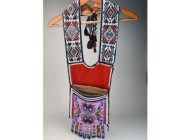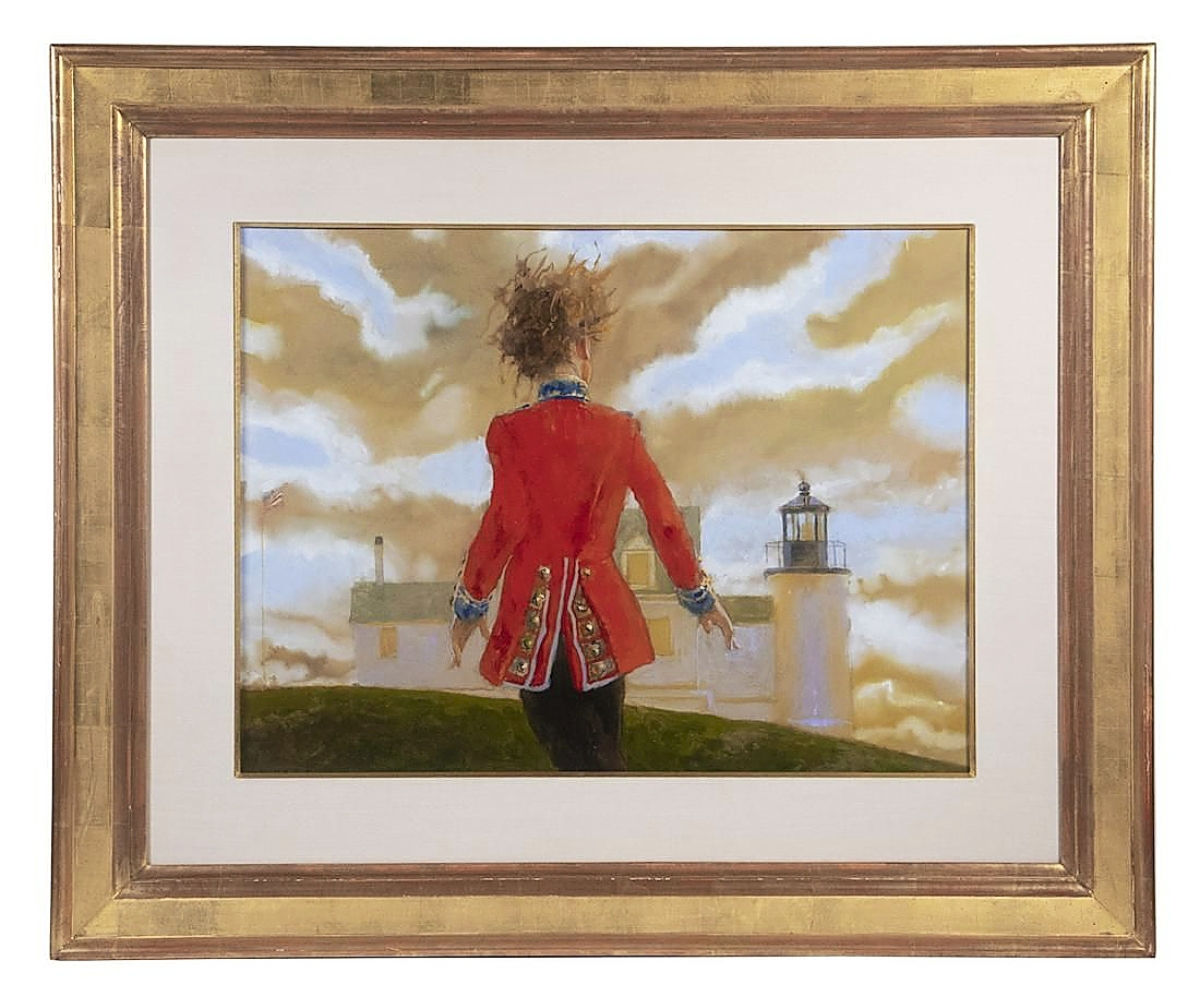
At $192,000, Jamie Wyeth’s “Study For A Lighthouse” was the star of the sale. The finished mixed media painting was on the dustjacket of Wonderous Strange: The Wyeth Tradition (1998) and a signed copy accompanied the mixed media work.
Review & Onsite Photos By Rick Russack, Catalog Photos Courtesy Thomaston Place Auction Galleries
THOMASTON, MAINE – True to form, Thomaston Place Auction Galleries’ August Splendor sale had an eclectic selection of material. From Hermes scarves to Chippendale furniture, midcentury pottery to weathervanes, European paintings to garden furnishings, rustic Adirondack furniture to custom-made banjos, artwork by Wyeth family artists to Asian antiques, as well as fine jewelry and more. It even included three paintings done by the auctioneer’s wife, Cali Veilleux. The 220-page catalog described more than 1,400 lots and included artist and collector biographies. There were more than one 100 bidders in the sales room for the Sunday sale, and good-sized crowds each of the other two days. The August 26-28 auction was live streamed on four internet platforms, there was active phone bidding and numerous absentee bids, with in-house bidders winning many of the lots. Fine art was a major draw for the sale, with six lots each selling in excess of $100,000; more than 30 items achieved five figure prices. The final tally for the sale, at press time, was $3.5 million.
A few days prior to the sale, Kaja Veilleux discussed the eclectic selection of material in the sale from the comfort of his office, which reflects the eclectic nature of his interests, as well as the variety of merchandise offered in his sales. There were dozens of carved ivories, early tin toys, mechanical banks, a collection of small carriage clocks, and paintings filled every wall. “We have two well-known collections for this sale with very good stuff. That’s bringing people in for previewing and, hopefully, that will give us a good result for the sale.”
There’s no question that works from Wyeth family artists – N.C., Andrew and Jamie – and other items from the Gary Haynes collection created a lot of interest. Veilleux had sold the first part of that collection in July and saved the best for last. Haynes grew up in Nashville, Tenn., and was taking mail-order drawing lessons while in high school. That led to a career in advertising. Watercolor classes at night at the University of Tennessee ultimately led to an abiding interest in the works of Andrew Wyeth, and Haynes eventually opened galleries in Nashville and Thomaston, Maine. He said “I wanted to find the places that Andy Wyeth painted. I wanted to see them for myself.” He did that and developed an interest in works by other members of the Wyeth family. He also collected works by other artists associated with the Wyeths, as well as their contemporaries. It was this collection of Wyeth family works that created the strong interest in the sale and drew the strong prices.
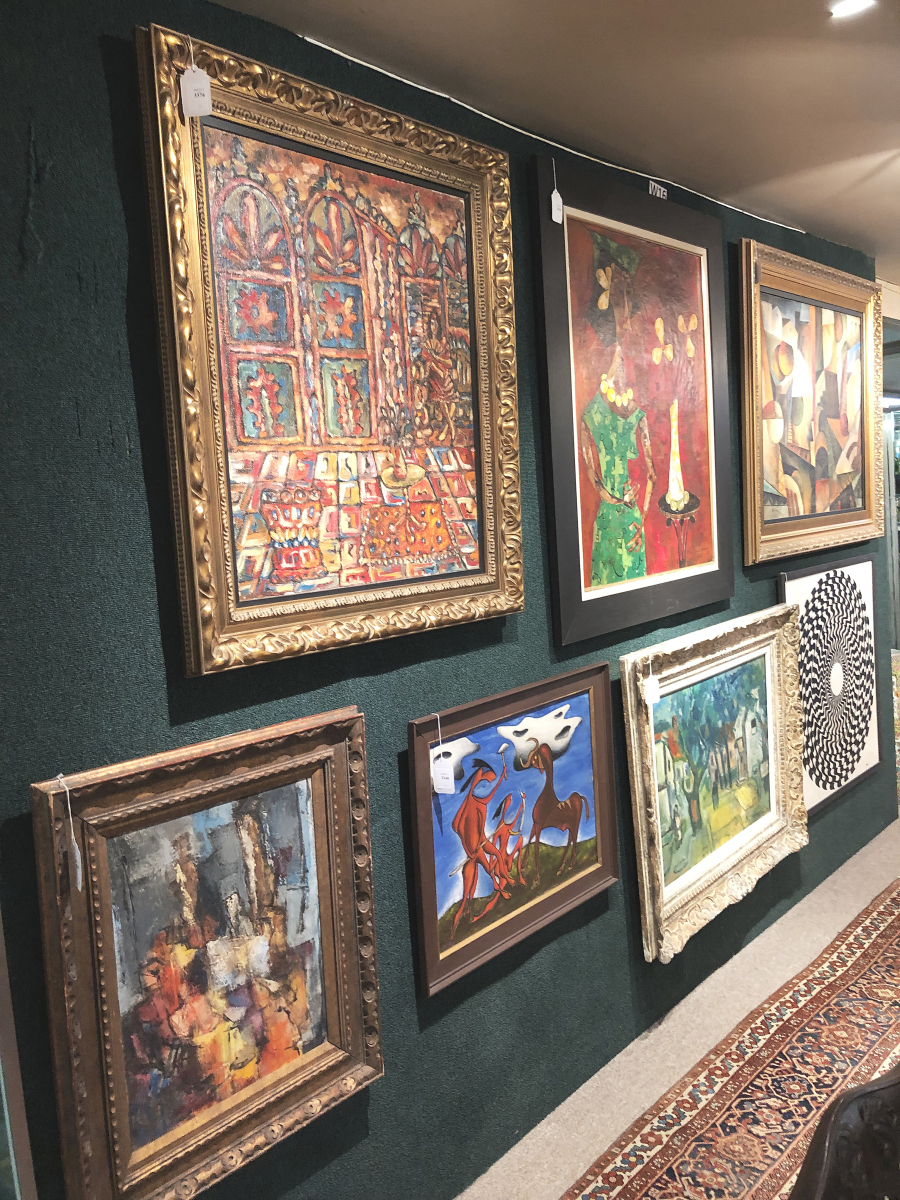
A small portion of the paintings on display in the gallery during the ten-day preview which drew hundreds of prospective bidders.
The two highest prices in the sale were earned by Jamie Wyeth (b 1946) mixed media works and the third highest price was earned by a watercolor by his father, Andrew Wyeth (1917-2009). Jamie’s 2003 “Study For A Lighthouse” earned $192,000, the highest price realized in the sale. Included with the study was a signed copy of the book, Wonderous Strange: The Wyeth Tradition. The painting was the final watercolor and gouache study for the oil painting on the dustjacket of the book. The British Guards Uniform used in the painting was sold separately and brought $6,600. Jamie’s “Kyle and the Influence,” done in 2000, earned the sale’s second highest finish at $180,000. The sale included several pencil signed and numbered giclee prints done by Jamie; editions were small and prices ranged to $4,800.
A watercolor by Jamie’s father, Andrew, earned the third highest price of the day, $162,000. It was done in 1969 and simply titled “The Pantry.” It had been exhibited at the Boston Museum of Fine Arts. A watercolor depiction of the Granary and Mill in Chadds Ford, Penn., done in 1959, sold for $54,000. Collotypes by Andrew ranged up to $3,900. An unsigned charcoal study for Lincoln Delivering his Second Inaugural Address, circa 1920, by N.C. Wyeth, (1882-1945) Andrew’s father, realized $27,000. There were several other Wyeth family works in the sale, as well as family photographs.
Other paintings also did well. An exceptional landscape by African American painter Robert Scott Duncanson (1821-1872) finished at $138,000. The catalog identified it as “Boatman Delivering Goods on the South Fork Shenandoah River, Virginia.” Considered a second-generation Hudson River School painter, Duncanson was influenced by the works of painters such as Thomas Cole and some of his works reflect the abolitionist sentiments of the day. His works are in several museum collections, including the Smithsonian.
A significant portion of the sale was devoted to the estate of Syril Frank, an avid collector, sculptor and painter. Her collection included two of the major pieces in the sale, large wood constructions by Louise Nevelson (1899-1988). One titled “Open Zag” was more than 80 inches tall and had an estimate of $350/450,000. It, and the second one, failed to sell during the auction but Veilleux, a couple of days later, said both were “probably” sold.
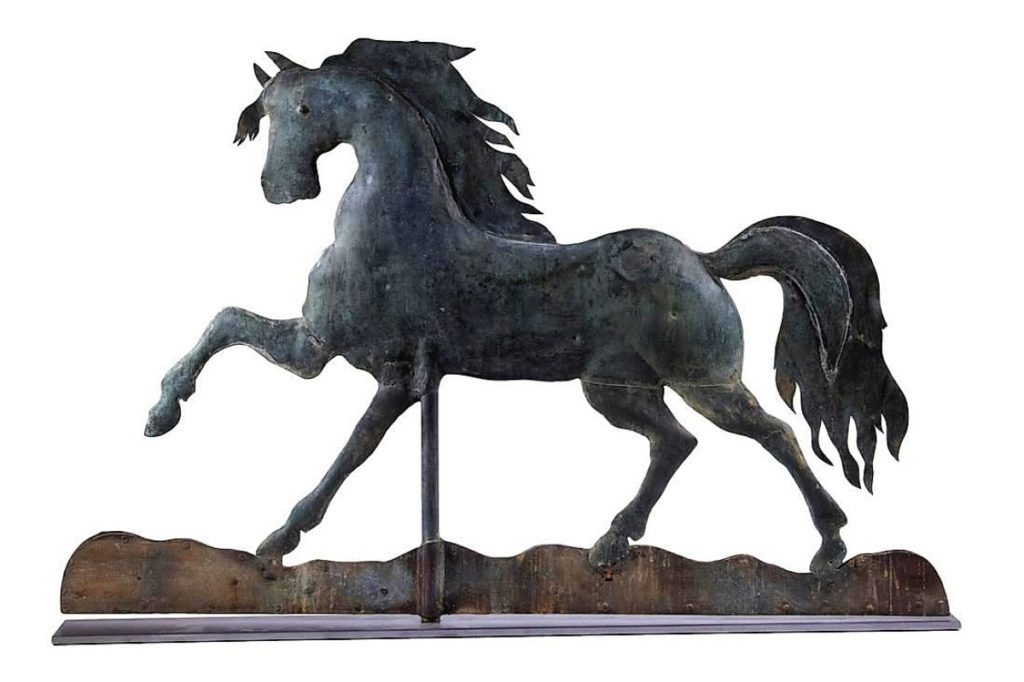
Bringing the highest price of the several weathervanes in the sale was this large prancing horse, attributed to Jewell. Circa 1860, it was 43 inches wide and sold for $16,800.
Frank’s collection included four works by Picasso, one of which sold for $78,000. It was a pencil signed etching, “Minotaure Aveugle,” from an edition of 97 that was part of the Vollard Suite of etchings, which had been exhibited at the Nassau County Museum of Art. Another etching from the same suite, “Quatre Femmes Nues et Tête Sculpté” sold for $22,800. There were three Cubist pencil signed color pochoirs by Picasso, each from a set of ten produced about 1920 that were from a different collection. They sold between $9,600 and $10,800. A Picasso Madoura pottery plaque from an edition of 500 brought $3,600.
With more than 1,400 items in the three-day sale, there was much more than paintings offered. A circa 1860 copper prancing horse weathervane attributed to Jewell, mounted on an iron support bar simulating the ground, sold for $16,800. Another weathervane, a full-bodied Jersey cow attributed to L.W. Cushing, found a new home for $8,400. Bringing $7,200 was a circa 1905 carved and painted double seat carousel horse, probably made by Herschel-Spillman, that had original surface. Someone had added the name “Upset,” which was the only horse to have defeated Man O’ War. A large carved oak lectern, 6 feet tall, with a detailed carved spread-winged eagle sold for $1,920.
A good selection of American furniture was offered. Bringing far more than its $600/900 estimate was a pair of circa 1785-90 mahogany ribbon-back side chairs from Portsmouth or the North Shore; the pair earned $8,400. A grain-painted Federal period tall clock in a pine and birch case, original throughout, including fret and brass finials, sold for $2,880. Bringing the same price, $2,880, was a circa 1735-40 transitional William and Mary/Queen Anne dressing table, probably from the Deerfield/Hadley, Mass., area.
Thomaston Place sales almost always include Asian and ethnographic materials. In this auction, a Chinese Qing carved jade vase, just shorter than 10 inches tall, realized $21,000. It was carved in high relief with a writhing dragon wrapped around the top. In all, there were more than 100 Chinese objects, including other jades, porcelains and hardwood furniture. A lot of 34 pieces of Chinese export porcelain sold – as-is – for $510. From the Frank collection, a carved and polychromed Egyptian/Roman funerary mask, dating to the First Century BCE, realized $11,400. A Roman full-length carved marble statue of Asclepius, the ancient God of medicine and health, dating to around the First Century CE or later, brought $10,800.
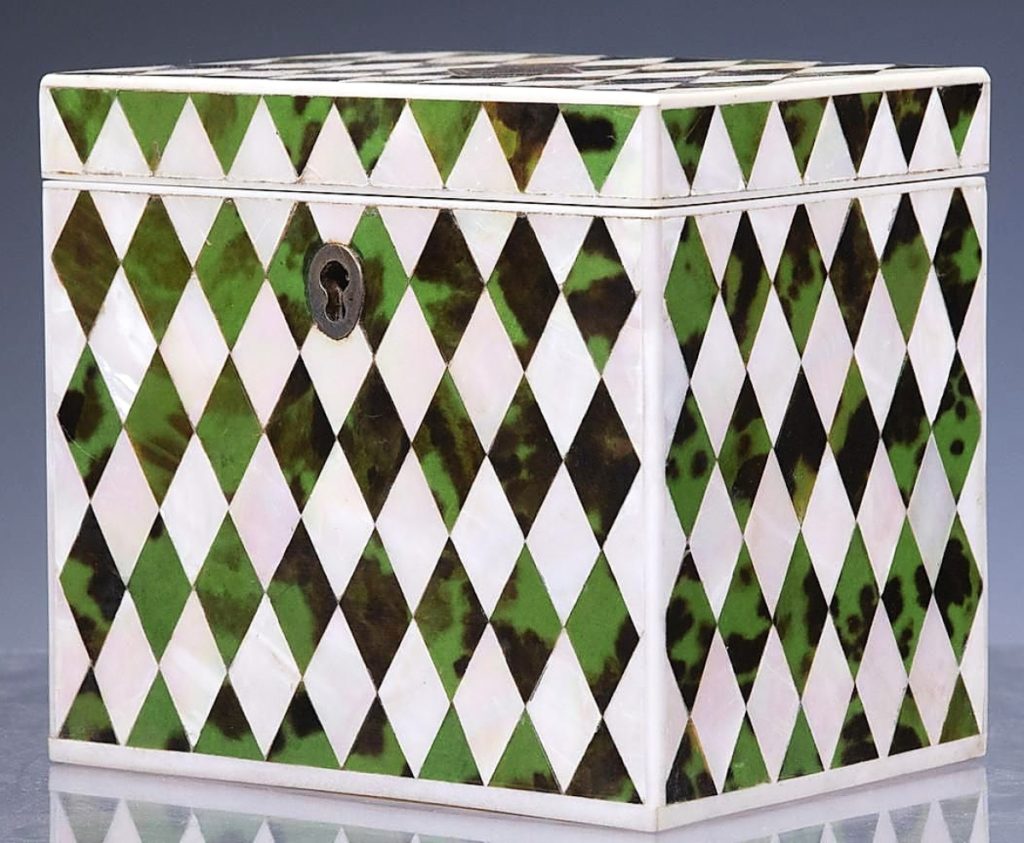
Thomaston Place usually has a good selection of tea caddies, and they bring strong prices, often well above estimates. That was the case with this example, which dated to the early Nineteenth Century and was inlaid with diamond-shaped green tortoiseshell and mother-of-pearl. It went out at $10,200.
We used the word “eclectic” earlier. The first day of the sale was characterized that way as the sale began with a group of garden furniture and a collection of fine musical instruments, including saxophones and banjos. Two Selmer saxophones, circa 1960, each sold for $8,400. The group of stringed instruments included two banjos made by Doug Unger dated to the first quarter of the Twentieth Century. One with an inlaid neck with a star motif earned $4,500; the other, with a carved heel and inlaid neck, closed at $3,900.
A few days after the sale, Veilleux said, “Sunday was wild. We had to put out more chairs because there were so many people in the gallery. The Wyeth material really attracted the crowd, and we had some good European paintings. We had two major collections for this sale, and we were able to use their names. Many buyers recognized those names and that really helped. I thought we had estimated properly but some things just blew those estimates away. I don’t know where the brown furniture people were on Saturday. It was very good material from a very good collector who didn’t want his name used. Dealers missed some good opportunities there. The paintings by living Maine artists did very well and the two Nevelsons, which we passed during the sale, have probably been sold by now. We had phone bidders lined up on more than 250 lots and we had hundreds of people here for the previews. So, if you were to ask me if I’m satisfied with the sale, my answer would be ‘absolutely!'”
Thomaston Place Auction Galleries will sell coins September 23-24, firearms and military memorabilia October 14 and toys on October 28.
All prices quoted include the buyer’s premium. For additional information, 207-354-8141 or www.thomastonauction.com.



































